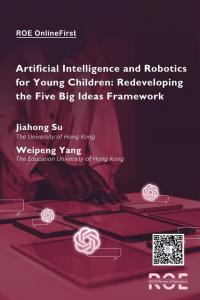Study from ECNU Review of Education Redevelops Framework for Teaching Artificial Intelligence and Robotics
Researchers redefine the “five big ideas of AI” to guide the education of preschool kids in the most rapidly developing fields.
SHANGHAI, CHINA, April 28, 2025 /EINPresswire.com/ -- Artificial intelligence and robotics (AIR) are quickly making their way into our lives. Therefore, it is important to introduce these topics to children and teens. Recently, researchers from Hong Kong have redeveloped the “five big ideas of Artificial Intelligence (AI)” from the AI4K12 framework to better suit kids younger than six years old. These principles and foundational concepts can help develop better educational guidelines for children to better understand and use AIR-based tools.Just like computers, the Internet, and smartphones have become commonplace in our daily lives, artificial intelligence and robotics (AIR) are the next technologies in line set to drastically change how we interact with the world and among ourselves. Various AI-driven applications are already in widespread use, such as Siri, Google Assistant, and ChatGPT, and both industrial- and consumer-grade robots are becoming increasingly capable and accessible.
In our modern societies, where people rely more and more on AIR systems to perform tasks, it’s essential to prepare children and teenagers to understand and use these tools effectively. To this end, the AI4K12 initiative was developed, which comprised a set of guidelines for teaching AI within the context of K-12 education. Notably, AI4K12 outlines “five big ideas of AI” as foundational concepts or key principles that are deemed essential to grasp AI. However, these big ideas are too complex for children younger than six years old.
Against this backdrop, a research team comprising Dr. Weipeng Yang, an Assistant Professor at the Education University of Hong Kong and Ms. Jiahong Su from the University of Hong Kong decided to revise AI4K12’s framework and identify five big ideas of AI that are better suited for young children, especially preschoolers. Their study was published online in the journal ECNU Review of Education on December 10, 2023. Notably, these authors had published another study in this journal on April 19, 2023, in which they proposed a theoretical framework to guide the use of AI tools, such as ChatGPT, in education.
The first big idea addresses the concept of AIR perception. Children should understand that robots and computers can use a variety of sensors to perceive their surroundings and make decisions accordingly. One way to teach this concept is through demonstration, using either a simple robot with an exploratory task or by having children role-play themselves as wandering robots with limited or altered sensing capabilities.
The second big idea introduces the concepts of AI representation and reasoning. Dr. Yang explains: “AI systems work on algorithms and use codes to interpret information, which is different from our understanding and thought process. Young children need to understand that AI’s process of perceiving the world is different from that of humans. They should acknowledge the unique features of AI that complement human qualities.” A hands-on activity like shape-sorting alongside a robotic friend may properly illustrate this big idea in a way children can comprehend.
The third big idea is related to AI learning. Children should understand that AIR systems can process very large amounts of data to arrive at their proposed results or solutions. Moreover, they should be aware that AI can learn from new information to help humans solve tasks.
The fourth big idea revolves around the concept of natural interactions between AIR and humans. Children should understand that AIR systems are developed by humans and lack consciousness or self-awareness.
Finally, the fifth big idea addresses the societal impact of AIR. Children must be taught that AI will have (or have already had) a profound impact on human lives and the world. “Educating children on AI right from the preschool will ensure effective application of AI tools by students,” highlights Dr. Yang.
The article also proposes several ways to engage young children in learning about the five big ideas of AI through the use of robotics. Specifically, the researchers emphasize the importance of interactive and memorable experiences, especially through acts of play and other hands-on opportunities to interact with AIR systems. “Our five big ideas of AI framework redeveloped from AI4K12 will help children better understand AI and its importance in the rapidly developing digital society,” concludes Dr. Yang.
Hopefully, children of all ages will soon be able to experience and understand AI in a healthy and responsible manner, leading to new applications and learning opportunities.
***
Reference
Title of original paper: Artificial Intelligence and Robotics for Young Children: Redeveloping the Five Big Ideas Framework
Journal: ECNU Review of Education
DOI: https://doi.org/10.1177/20965311231218013
Authors: Jiahong Su1 and Weipeng Yang2
Affiliations
1. The University of Hong Kong
2. The Education University of Hong Kong
About ECNU Review of Education
The ECNU Review of Education is an international peer-reviewed open access journal, established by the East China Normal University (eponymous ECNU). The journal publishes research in the field of education, with a focus on interdisciplinary perspectives and contextual sensitivity. It seeks to provide a platform for the pedagogical community to network, promote dialogue, advance knowledge, synthesize ideas, and contribute to meaningful change.
About Ms. Jiahong Su
Ms. Jiahong Su is currently a Ph.D. candidate in the Faculty of Education at the University of Hong Kong. Her areas of reasearch include technology education, AI, and STEM in early childhood education. She has published many papers in the field of Artifical Intelligence, coding, teacher education and computational thinking. She has also served as a reviewer for various journals, including Computers & Education, Education and Information Technologies, Early Child Development and Care, and Early Childhood Education Journal.
About Assistant Professor Weipeng Yang
Dr. Weipeng Yang is an Assistant Professor at the Department of Early Childhood Education in the Education University of Hong Kong. His research focuses on early childhood curriculum and pedagogy, with specialized interests in STEM education, technology integration, socio-emotional wellbeing, and culture. He holds multiple editorial positions, including Editor at Journal of Research in Childhood Education, Associate Editor at Journal for the Study of Education and Development, and Convenor of Curriculum, Assessment and Pedagogy SIG at British Educational Research Association, among others.
Li You
ECNU Review of Education
+86 21 6222 4545
roe|ecnu.edu.cn| |roe|ecnu.edu.cn
Legal Disclaimer:
EIN Presswire provides this news content "as is" without warranty of any kind. We do not accept any responsibility or liability for the accuracy, content, images, videos, licenses, completeness, legality, or reliability of the information contained in this article. If you have any complaints or copyright issues related to this article, kindly contact the author above.
All-Pro Commercial Cleaning Earns Top Ratings Across Central Florida—Here's Why Customers Keep Coming Back
Audfly’s Directional Sound Modules Becoming a Standard in Smart Devices
Motivando Opens Crowdcube Campaign to Let Users Own a Piece of Moti App
Więcej ważnych informacji
 Jedynka Newserii
Jedynka Newserii

 Jedynka Newserii
Jedynka Newserii

Ochrona środowiska

Kraje dotknięte powodzią z 2024 roku z dodatkowym wsparciem finansowym. Europosłowie wzywają do budowy w UE lepszego systemu reagowania na kryzysy
W lipcu Parlament Europejski przyjął wniosek o uruchomienie 280,7 mln euro z Funduszu Solidarności UE na wsparcie sześciu krajów dotkniętych niszczycielskimi powodziami w 2024 roku. Polska otrzyma z tego 76 mln euro, a środki mają zostać przeznaczone na naprawę infrastruktury czy miejsc dziedzictwa kulturowego. Nastroje polskich europosłów związane z funduszem są podzielone m.in. w kwestii tempa unijnej interwencji oraz związanej z nią biurokracji. Ich zdaniem w UE potrzebny jest lepszy system reagowania na sytuacje kryzysowe.
Handel
Nestlé w Polsce podsumowuje wpływ na krajową gospodarkę. Firma wygenerowała 0,6 proc. polskiego PKB [DEPESZA]

Działalność Nestlé w Polsce wsparła utrzymanie 45,2 tys. miejsc pracy i wygenerowała 20,1 mld zł wartości dodanej dla krajowej gospodarki. Firma przyczyniła się do zasilenia budżetu państwa kwotą 1,7 mld zł – wynika z „Raportu Wpływu Nestlé” w Polsce przygotowanego przez PwC na podstawie danych za 2023 rok.
Polityka
M. Kobosko: Surowce dziś rządzą światem i zdecydują o tym, kto wygra w XXI wieku. Zasoby Grenlandii w centrum zainteresowania

Duńska prezydencja w Radzie Unii Europejskiej rozpoczęła się 1 lipca pod hasłem „Silna Europa w zmieniającym się świecie”. Według zapowiedzi ma się ona skupiać m.in. na bezpieczeństwie militarnym i zielonej transformacji. Dla obu tych aspektów istotna jest kwestia niezależności w dostępie do surowców krytycznych. W tym kontekście coraz więcej mówi się o Grenlandii, autonomicznym terytorium zależnym Danii, bogatym w surowce naturalne i pierwiastki ziem rzadkich. Z tego właśnie powodu wyspa znalazła się w polu zainteresowania Donalda Trumpa.
Partner serwisu
Szkolenia

Akademia Newserii
Akademia Newserii to projekt, w ramach którego najlepsi polscy dziennikarze biznesowi, giełdowi oraz lifestylowi, a także szkoleniowcy z wieloletnim doświadczeniem dzielą się swoją wiedzą nt. pracy z mediami.

![Nestlé w Polsce podsumowuje wpływ na krajową gospodarkę. Firma wygenerowała 0,6 proc. polskiego PKB [DEPESZA]](https://www.newseria.pl/files/1097841585/fabryka-nesquik_1,w_85,r_png,_small.png)






.gif)

 |
| |
| |
|